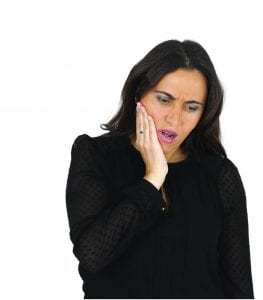Suffering From Jaw Pain? STAR Physical Therapy Can Help!


Jaw pain defined
The temporomandibular joint has two pairs of joints that make it possible for the jawbone to both rotate and slide. This joint connects the lower jaw to the skull. The temporomandibular joints can be found on either side of the head in front of the ears.
The lower jaw has rounded ends that glide in and out of the joint socket when you talk, chew, or yawn. (These are called the condyles.) They are covered with cartilage and are separated by a small shock-absorbing disk, which keeps the movement smooth. These joints allow us to talk, chew, and yawn.
When one or more of these joints become inflamed or painful, the condition is called temporomandibular joint disorder (TMJD, TMJ, or TMD).
Causes of TMD
Pain can be elicited in the joint of the jaw due to problems of the teeth such as damage to the surface, loose or lost teeth, poor alignment (malocclusion) when biting, sensitivity, and neglect. Overuse of the muscles of the jaw can occur if a person chews gum continuously, bites fingernails or pencils, grinds the teeth, has a habit of clenching the jaw (bruxism), biting the cheek or lip or thrusting the jaw out when speaking, exercising or other actions. Continual use of the muscles of the jaw can create trigger points in the muscle tissue that cause myofascial pain syndrome. Posture contributes to the jaw position. The forward head position puts a strain on the muscles, disk, and ligaments of the TMJ. The jaw is forced to rest in an open position, and the chewing muscles become overused.
Jaw pain can also occur when the disk erodes or moves out of its proper place (disk displacement). Pain can occur with joint damage by a blow or other impact that may or may not result in fracture. Arthritis, tumors, and infection can also damage the joint’s cartilage.
Often, it is not clear what is causing the TMJ symptoms but it does occur most commonly in women between the ages of 30 and 50.
Symptoms of TMD
The symptoms of TMD can be temporary or last for years. Jaw pain is the most common symptom. TMD symptoms include:
• Jaw pain
• Jaw fatigue
• Difficulty opening your mouth to eat or talk
• Ringing in your ears
• Dizziness
• Headache
• Popping sounds in your jaw
• Neck pain
• Locking jaw
TMD can cause the jaw to lock or get stuck in a certain position. You may experience headaches, feel pain when chewing certain foods, or have difficulty fully opening your mouth.
CAUTION: Jaw pain also can be a symptom of a heart attack. Seek medical care immediately if jaw pain is accompanied by: Chest pain, Shortness of breath, Dizziness, Left arm pain, Numbness in the left arm, or Nausea.
Measurement of TMD
TMD is measured by asking about various types and durations of muscle, joint, facial pain, difficulty with chewing, and joint sounds. Doctors, chiropractors, dentists, and various medical specialists including physical therapists can perform TMD evaluations.
To identify the cause of your symptoms, your physical therapist may:
• Review your medical history and discuss any previous surgery, fractures, or other injuries to your head, neck, or jaw.
• Ask you to describe your pain, including headaches, and observe any pain patterns in the neck and TMJ.
• Conduct a physical examination of your jaw and neck, including the soft tissue and muscles in the area.
Your physical therapist will evaluate your posture and observe how your cervical spine—the upper portion of your spine, situated in your neck—moves. Your physical therapist will examine your TMJ to find out how well it functions and whether there are any abnormalities in your jaw motion.
If, after the examination, your physical therapist suspects that your pain is a result of the position (“alignment”) of your teeth, the therapist will refer you to your dentist for further examination.
How is Physical Therapy beneficial for TMD?
Your physical therapist can help you restore the natural movement of your jaw and decrease your pain. Based on your condition, your therapist will select treatments that will work best for you. Your treatments may include:
Posture Education
If you sit with your head in an increased forward position, you are placing greater strain on the muscles beneath your chin, causing the lower jaw to pull back and the mouth to be in an open position even when resting, increasing stress on the TMJ. You also might be overworking the jaw muscles to force the jaw closed so your mouth isn’t open all the time. Your physical therapist will teach you to be aware of your posture so that you can improve the resting position of your jaw, head, neck, breastbone, and shoulder blades when you’re sitting and walking.
Improving Jaw Movement
Physical therapists use skilled hands-on techniques (manual therapy) to gently increase movement and relieve pain in tissues and joints. Your physical therapist may use manual therapy to stretch the jaw to restore normal joint and muscle flexibility or break up scar tissues (“adhesions”) that sometimes develop when there is constant injury. Your physical therapist will teach you special “low-load” exercises that don’t exert a lot of pressure on your TMJ but can strengthen the muscles of the jaw and restore a more natural, pain-free motion.
Special Treatments
If your pain is severe, your physical therapist may provide treatments such as electrical stimulation or ultrasound to reduce it. Dry Needling may also be applied to restore healing of tissue, release tension, and improve mechanical motion.
Referral to a Dentist
If your TMD is caused by teeth alignment problems, your physical therapist can refer you to a dentist who specializes in TMD, who can correct the alignment with special appliances such as “bite guards” that create a natural resting position to relax the TMJ, relieve pain, and improve jaw function.
